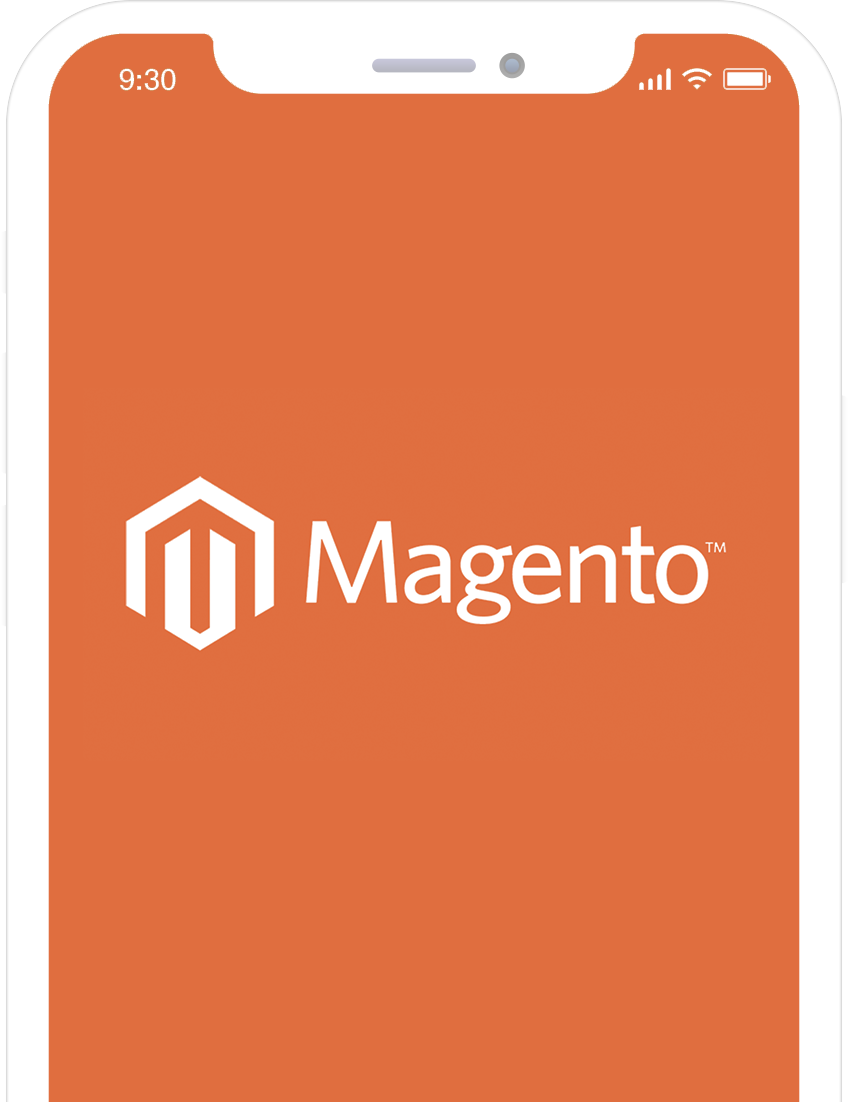Shopify vs Magento: Overview
Shopify and Magento are two of the leading ecommerce platforms used by ecommerce brands across the world.
According to BuiltWith, amongst the top million ecommerce stores, Shopify powered a whopping 24% of those compared with 8% powered by Magento. Both ecommerce platforms offer a wide range of features that you'll need to start, grow and scale an online store easily around the world. Magento historically led ecommerce online however in recent years Shopify has become a dominant leader with its easy-to-use features and scalable tech stack.
Shopify provides all the hosting out of the box, meaning you won't need to find hosting providers to store the code files. The platform comes with a drag-and-drop content management system called
Shopify Online Store 2.0, a large library of themes to choose from and a secure and powerful checkout with built-in payment processors that has proven to convert more customers online. Shopify originally targetted small businesses looking to start businesses and sell online, however since the launch of Shopify Plus and
Shopify Hydrogen Shopify is leading enterprise size
brands choosing to migrate to the platform such as Gymshark & SKIMS. Large global brands are choosing Shopify as it offers agile ways to scale multi-million-pound businesses with ease and integrates natively with other enterprise-level technology.
Magento, on the other hand, is an open-source platform whereby you have more control over the foundations of its setup including the hosting, domain name, payment processors and databases. Magento has seen a downfall in the number of brands using it as other players have taken market share. However, by the nature of Magento being open-source, this means that developers can access the entirety of the code allowing developers to have more customizability over areas such as the checkout. Alongside the direct access comes all the server security, as well as the application of patches to the Magento core codebase, whilst this is all taken care of for Shopify customers.
Before we dive into comparing the features, pros and cons that the two ecommerce platforms offer, let's explore a key overview of what each platform offers, the features they include to help provide insight in our comparison of Shopify vs Magento.
What is Shopify?
Shopify is a complete commerce platform that aims to provide businesses with everything they need to sell both online and offline, alongside providing all the tools and architecture to grow and scale too. Millions of businesses rely on the platform every single day, leveraging Shopify's ability to design and build online stores, sell in multiple places around the world, sell on multiple devices such as on the web, phones, tablets and brick-and-mortar stores or pop-up shops too. Shopify acts as a centralised admin to run a business selling products to a multitude of different channels including social media channels & online marketplaces too!
Shopify doesn't just provide the platform that runs ecommerce, they provide all of the hosting, servers, security and architecture to store and run the business from taking away the brand's requirement to set this up or manage it. Shopify's main product is allowing customers to sell online - giving them access to website templates for a whole host of different designs and features. The platform also offers a full back-end admin to allow brands to manage inventory, payment processing and order processing.
Shopify's checkout is renowned as the world's highest converting checkout too, with accelerated payment options and all the major ways to pay. Shopify also comes equipped with marketing tools for SEO, social media channels and content writing.
Shopify considers the entire business and offers upgrades and features tailored towards helping brands grow. For example, upgrading to Shopify Plus gives brands access to advanced checkout customisations, increased capacity to take orders and dedicated enterprise-level support.
Whilst Shopify's technology is highly regarded and scalable, one of the key benefits is the quality and amount of third-party app providers that come with the platform via the Shopify App Store. The App Store has
thousands of apps and features built by third-party developers to customise the store without ever once touching the code. There is also a marketplace of Shopify Experts that the user community can hire to build custom solutions for their businesses.
Shopify allows brands to create unique and seamless online experiences for their customers and scale the business almost infinitely leveraging the power of the servers and checkout security that Shopify brings. Brands can market their products to multiple channels, host their domain securely and sell around the world with
Shopify Markets.
Interesting in our Shopify Work?
See our portfolio.
What is Magento?
Founded & released in 2008 by Varien - Magento is a little different to Shopify because it is an open-source ecommerce platform meaning users can have full access to the backend whereas Shopify is a closed hosted-for-you tool. Magento is used by leading brands such as Omega & Dior and has grown to become one of the most popular ecommerce platforms. Magento released a new version of its platform which caused a lot of negativity due to excessive bugs, issues and challenges for merchants to upgrade. This did effect the image of the platform. The platform is written in a programming language called PHP and uses other frameworks such as Laminas and Symfony. Magento uses MySQL or MariaDB database management systems that developers are required to set up to use the platform.
As you'd expect Magento comes equipped with a wide range of features tailored for ecommerce merchants including a backend CMS, shopping cart, checkout, support for multiple payment gateways and capabilities required to manage and ship orders/inventory. Alongside the logistical management tools that Magento brings, it also provides marketing features such as
SEO controls, catalogue management and more.
Magento is highly focused on enterprise-level businesses containing technical features such as caching that can scale to large enterprise levels. Given that Magento is open-source developers do have complete access to the way it works, arguably creating an open opportunity for customisability. Magento is a powerful platform with a large range of features and capabilities that ecommerce brands can use to grow and scale their business. Magento was acquired by
Adobe in 2018 which have continued to invest and grow the platform.
Shopify vs Magento: What's the Difference?
So now we get to the fun part, comparing each platform against one another following our overview of both Magento & Shopify. Throughout this article, we'll be exploring the different of what we think are key decision factors for businesses deciding between the two. We'll be exploring how the platforms are hosted, the features they include, the pricing, security, usability, support, shipping, logistics, inventory, customisations, support, plugins & apps, internationalisation and finally the content management system (CMS). We'll also dive into the benefits and disadvantages of each platform too!
Shopify vs Magento: Features
Both Shopify and Magento are designed for ecommerce brands, so naturally, both platforms come equipped with the key features you'll need to run a DTC business. When we compare using Magento and Shopify on a day-to-day business Shopify is a little simpler and visually more appealing in its UI design. Both Magento and Shopify come with very similar main features such as the ability to create product listing (collection) pages, product pages, content/editorial pages, blogging functionality, shopping carts, checkout and store search features. It has been noted that Magento has more features out of the box such as bundling and the ability to create child groups of products within collections whereas Shopify is reliant on its large network of apps. However, in recent years this is rapidly changing as Shopify releases more and more features natively. This is arguably no longer the case as Shopify demonstrates a wide feature range on the platform.
If we compare the marketing features of the two platforms - Shopify is well known for its wide-reaching integrations with tech partners such as Klaviyo, Yotpo, SKIO and MailChimp giving brands to ability to launch email marketing, cart recovery, loyalty,
subscriptions and reviews with ease. Similarly, you can natively connect Shopify to your advertising platforms such as Meta, TikTok & Pinterest to sell and exchange data between the platforms to maximise growth.
The majority of Magento's marketing functionality comes from it's marketplace. To launch email marketing you'll need to install extensions or lean on web developers expertise to provide native integrations between the platforms you wish to connect. Some advertising partners have invested to build native connections and extensions for Magento brands to use - such as Meta, Google or Instagram however others including TikTok you'll either need to build this yourself or rely on a third party who has already done this - however additional fees are likely to apply.
Shopify vs Magento: Payment Gateways
Without a
payment gateway ecommerce stores cannot exist. A payment gateway is a service that allows a business to accept and process payments from customers and receive money. In the use-case of ecommerce, a payment gateway is used as an intermediary between the customer, the business, and their financial institutions.
Shopify integrates with over 100 payment gateways meaning that merchants can allow their customers to pay in a way that is familiar and trusted by them. Shopify has a payment gateway called Shopify Payments which allows brands to offer all major debit, credit cards, and accelerated payments including Apple / Android Pay without the need for a third-party gateway. However, if you want to offer a third-party payment gateway then Shopify has native one-click integrations with hundreds including PayPal, Amazon Pay and Klarna. Shopify Payments is powered by Stripe. Shopify's large range of payment gateways makes the platform very attractive to businesses around the world, as each region typically has unique payment types unique to that territory for example some countries are used to pay on delivery or always using PayPal. However, if there is a payment gateway outside of Shopify's list then regretfully you cannot use it as Shopify's checkout is locked to the gateways that they have approved - this can be challenging for restricted categories such as CBD sales.
Out-of-the-box Adobe Commerce offers integrations with PayPal, Braintree, and Authorize.Net payment service providers and does not natively offer its payment gateway. If a merchant does want to integrate an additional gateway beyond those 3, then they will need to rely on a developer to integrate a third-party gateway which is typically more complicated than Shopify's
large integration list. The benefit here is that Magento is more flexible if you want to integrate an unsupported gateway however the complexity is higher.
Whilst Shopify does make it easier to integrate with a third party it's important to remember that they come with a surcharge fee from Shopify if you choose to offer something beyond Shopify Payments. If you stick with Shopify Payments then you can avoid the additional third-party payment fee.
Shopify vs Magento: Web Development and Coding
Considering how your store is built and the development skills needed is an important consideration for how you grow, optimise and scale your business. Magento and Shopify are both built using entirely different web development languages. Magento is built using a programming language called PHP whilst Shopify uses its home-grown templating language called Liquid that pieces together CSS and HTML of a store. PHP is one of the original programming languages however have seen a large drop in popularity over recent years as more modern frameworks are released. Liquid is an open-source template language that Shopify created based on a language called Ruby. Liquid is used to build Shopify themes and load content on the store.
It's important to note that PHP and Liquid are safe, secure and trusted languages that are entirely fit for building an ecommerce store. Given the downward trend in popularity of PHP, it may become increasingly difficult to source the skills of developers and Shopify has attracted a huge number of partners who can build using its system. Liquid is also quick to learn for most front-end web developers. Other platforms like wordpress use PHP too.
Given Shopify does impose more limitations given the fact the backend is relatively locked, then very custom and unique experiences may require more open-source development languages. However, Shopify does now support
headless architecture allowing brands to move away from Shopify's more restrictive
monolithic approach. Magento requires a lot more server knowledge than Shopify and requires access to a professional development team whereas basic Shopify stores do not require this support as they work out of the box without the need for coding knowledge. However as a Shopify company scales, then a dedicated development team will be required to allow the store to be optimised and customised.
Ultimately, the programming language that is best for your ecommerce store depends on your specific requirements and preferences. Magento requires a lot more coding knowledge than Shopify to create a store from scratch and is therefore better suited for e-commerce businesses with access to a professional developer team. While basic Shopify stores are simple to set up with minimal coding knowledge required, it is still recommended to hire expert developers so that an online store can stand out from the competition. In the ecommerce world today, there are so many new stores popping up month after month which is making it more difficult for websites to differentiate themselves from the competition and deliver a truly unique ecommerce experience, especially as similar templates are used.
Shopify vs Magento: Usability
The user interface of both Shopify & Magento has well-developed and optimised UI experiences for the merchants that use them. It will always be a personal choice on what experience you prefer, however in our experience merchants typically prefer the look and feel that Shopify offers as it feels modern, clean and easy to navigate. Shopify is a sales tools loved by it's customers and delivers unique and outstanding storefront to customers with performance in mind.
Shopify is well known to be easy to use, it's obvious where to find key areas such as orders, products and collections. Shopify has incentivised third parties to leverage their UI toolkit called
Polaris to enable third-party apps to still maintain a similar and familiar look and feel. Shopify's CMS called
online store 2.0, is known to be beautiful, highly visual and easy to use with drag and drop functionality.
Using Magento however, is more complex and requires longer to build familiarity with using it. Magento does feel more complex, with elements that may require technical and developmental knowledge to understand how to use. That said there is an argument that out of the box, Magento offers more customisability in the backend to build new functionalities to meet the needs of your business whereas Shopify is more restrictive. That said it can be a learning burden on teams trying to get to grips with how Magento works. If development resources are available, then both platforms can be utilised to make usability as easy as possible.
Shopify vs Magento: Pricing
Shopify offers a variety of plans based on the complexity, size and feature requirements of the business. Shopify's barrier to entry is very with very low-cost basic plans available. The plans then scale up to allow more users, advanced analytics and additional stores. For bigger brands,
Shopify Plus gives access to more advanced features such as the ability to customise the checkout. Learn more about
Shopify Pricing here.
Magento also has several different tiers to choose from. Merchants can opt for the basic version called Magento Open Source which is free to use. However, higher tiers are available that require significant investment including Magento Commerce and Magento Commerce Cloud.
Typically, the higher the plan or tier the more advanced features you'll receive and this should be assessed on a business-by-business basis. The most attractive element about Shopify is it includes your web hosting, security, patching and upgrades free of charge whereas Magento requires you to manage the hosting and servers yourself. Platform upgrades typically require developers to deploy, unlike Shopify where most are done automatically free of charge. However that said, do consider Shopify's transaction fees or third-party payment gateway costs in your budget as these can add up when compared to non-third party services.
Shopify vs Magento: Security
Both Shopify and Magento are regarded as highly secure platforms when set up correctly and have security-related features included designed to protect your business.
Shopify hosts your store on your behalf and manages all of the security of its servers, to keep your business safe. Shopify even has
fraud protection features to flag potentially fraudulent orders too! Shopify uses secure socket layer encryption to protect the customer's store visit connected with the servers at Shopify. Shopify has a 24/7 security team that work around the clock to keep you and your business safe online.
Whilst Magento is built in a way that can be used securely, it's important to note the merchant is required to set up and manage the servers and SSL certificates. Whilst there are several hosting providers, it does require additional steps and consultation to ensure your store is secure and protected online.
Shopify vs Magento: Customization
Having the ability to customise your store is vital to stand out from the competition and offer the very best experience to your customers. Customisations may include the visual look and feel that a customer sees when they land at your store, or customisations may include the features that you offer in your store. The main reason why brands want to customise their stores is to offer a consistent branded experience, to maximise key ecommerce KPIs such as conversion rate,
average order value and engagement on their store. Let's dive into how customisable each of the platforms are.
Shopify is highly customisable in terms of how you offer a unique look and feel online. Firstly, you can build a
bespoke theme that is ultimately up to the designers and developers to build something that is entirely unique to your brand. Note you will need to stick to the typical page types that Shopify offers but the look and feel can be up to you. Alternatively, you can choose a
theme from Shopify's library. Shopify's theme library is growing all the time and has a wide range of design styles to match your brand - some of the themes are free too! Once you've chosen a theme, you can then use Shopify's Theme Editor to customise and add content with ease, merchants love how easy it is to manage content with Shopify's native drag and drop CMS. However, Shopify's backend dashboard is a little more restrictive making it harder to change the native way that Shopify works. For example if wanted to change a core feature of Shopify such as the URL structure then this would not be possible. However recent updates form Shopify are heading towards more freedom to control the admin.
Given Magento's code is entirely open-source, developers do have more freedom to control the way the platform works. Similar to Shopify, you can build bespoke themes for Magento or choose from their library of approved themes too. Merchants like the customizability that the checkout brings and how it can offer unique experiences for customers - especially beneficial for business that do not sell in a conventional way. However, whilst Magento does offer the ability to be customisable - it all requires the skills and investment into developers to complete this. Similarly, it can be a significant overhead to keep maintaining the customisations as Magento updates the platform - your customisations may need updating too.
Shopify vs Magento: Support
Shopify is renowned for excellent customer service for their merchants. Brands that use Shopify can access 24/7 support via email, live chat and telephone too. Shopify has an AI assisted help centre to help merchants get answers quickly and improve the longer life cycle of support requests. For store owners that opt for Shopify Plus or enterprise level plans then dedicated merchant success managers are assigned to provide tailored and trusted support. Shopify offers hunderds of tutorials too.
Magento does offer customer service however this isn't 24/7 from Adobe. Magento does have a comprehensive knowledge base and help center that brands can use however these brands may find themselves more reliant on their agency partners for support. For enterprise-level plans Adobe does offer dedicated account managers however this does come with a cost. The flexibility of support requirements will be unique to difference companies.
Shopify vs Magento: Shipping and Inventory
Both Shopify & Magento offer adequate order and shipping management features that allow you to process, manage and log orders that you receive through your store. Both platforms offer the ability to manage orders online and in-store.
Shopify has a native order management system built into the backend of their platform. Merchants can track & manage inventory from multiple locations, process orders, store customer information and also manage shipping notifications natively. Shopify is integrated with most major couriers so once a tracking number is provided, Shopify syncs updates to your customer automatically. Shopify also offers a wide range of Shipping option settings, allowing you to offer unique prices based on weight, split shipments, offer different speeds and manage international shipping. Shopify also has native integrations with a number of dropshipping solutions too, to make dropshipping a breeze. Shopify allows brand to store unlimited numbers of products, inventory amounts and collections through its platform.
Magento also offers all of the key shipping and inventory management features you'd expect. Magento offers methods to help you to fulfil orders efficiently and also provides a birds-eye-view of global inventory. Merchants can fulfil orders and offer POS features too. Magento does not limit the number of products you can store however the more data you store on a Magento store will increase the server size and may impact the speed based on your set-up.
If you require a more complex inventory management system then both platforms offer integration to third-party providers such as Linnworks, Brightpearl and Netsuite for more customization options.
Shopify vs Magento: Plugins and Apps
Both Shopify and Magento have a large network and ecosystem of third-party apps and plugins to add new features and functionality to your store.
Shopify has a gated app store, that only approved technology app partners will appear in. The apps you'll find in the app store range hugely from on-site features, loyalty schemes, sales features, accountancy, email marketing, reviews and more. There are over
8,000 and growing apps in Shopify's app store. If you are looking to add a feature to your it's highly likely that Shopify will have an app for that. Most apps are simple to install and don't require a developer, however for more complex integrations unique to your business then technical support will be needed. Shopify moderates its app store to prevent poor quality or harmful apps from being available to merchants.
Custom Apps can also be built entirely bespoke to unlock the full potential of a Shopify store and tailor features to your specific requirements. Most apps and add-ons do allow a free trial too to allow business owners to consider all the things their business needs and whether it achieves the desired result.
Magento has a similar app called the Adobe Commerce Extension Marketplace, which offers over 4,000 extensions with a wide range of use cases to extend the functionality of your Magento store. Magento is known to require more developmental input therefore you may need the support of developers when integrating new extensions into your store.
Shoify vs Magento: International Selling
Shopify offers a complex suite of features to help you sell internationally. There are two key approaches brands take - whether they create separate Shopify instances for each territory or leverage Shopify Markets to serve the globe dynamically from one store. Shopify Plus offers up to 9 expansion stores to merchants to expand additional localised stores.
Shopify Markets and Shopify Markets Pro offer a suit that allows merchants to set unique prices per currency/location, set up specific shipping rules and apply unique languages. Shopify Markets allows brands to offer unique content per market and also change the URL or subdomain too.
For an in depth guide on
how to sell internationally on Shopify, be sure to read our helpful article!
Magento natively allows you to manage different instances of your store and deploy product catalogues accordingly. Similarly, the platform allows you to use language packs to offer localised experiences to your customers.
Shopify vs Magento: Content Management Systems
Shopify
CMS is arguably one of their most favoured features, with its drag-and-drop website builder functionality and ability to build out pages using content blocks and sections without the need for developers. Shopify allows you to create, and manage different content types including products, collections, pages and blogs. Shopify also includes SEO features & functionality to allow you to update page titles, meta-descriptions and the robot.txt file. Shopify automatically manages the sitemap file too. Shopify allows you to create additional fields of data called metafields or metaobjects to expand how you manage content seamlessly across your store.
Magento has a powerful content management system with page builder capability and also a WYSIWYG editor. The editor also has custom fields and can be used to manage products, product listings and different page types. Magento's user interface is arguably more confusing and not as visually beautiful. Entrepreneurs & sellers are increasingly choosing Shopify for it's powerful CMS. Everyone has their own preference and people share their own unique insights, if you can demo both platforms before choosing or read more about peoples experiences in forums.
Pros and Cons of Shopify
Shopify is growing extremely fast taking more and more of the ecommerce market share. When Shopify was invented it was mainly used by small businesses or beginners however as the platform has evolved it's now a great choice for enterprise-level fast-growing businesses around the world.
Whilst we could write a much longer list here are some of the main advantages of using Shopify to grow an online store business:
• Shopify's UI is beautiful and easy to use
• You don't need code knowledge for basic stores
• Large library of themes and templates via the theme. library
• 100s of native built-in payment methods
• 24/7 customer support with phone & live chat
• Huge gated app store
• Highly scalable with power managed hosting and security
As with any platform there are always some disadvantages
• The admin is more restrictive, making it harder to make fundamental functional changes.
• You cannot change the URL structure
• Additional fees for third party gateways
Pros and Cons of Magento
Magento is a very powerful and versatile ecommerce platform, and is popular among enterprise level businesses. Here are some of the key pros of using Magento:
• The platform is customisable by developers
• It has advanced inventory and fulfillment options natively out of the box
• You can sell internationally natively with the platform
• It offers an advanced content management system
There are some potential drawbacks to using Magento. Here are some of the potential Magento cons and disadvantages:
• You have to manage the hosting yourself alongside the security of the store
• Magento is typically more complex to manage than a Shopify store
• The development investment in Magento is typically more than Shopify
• There is not 24/7 customer support from Adobe
Shopify vs Magento: Conclusion
Both Shopify & Magento offer tailored and specialised solutions to create, manage and grow an online store - both platforms have a proven track record of doing so. The decision between Shopify & Magento always comes down to the unique requirements of your business. However it is important to note that more brands are choosing Shopify than Magento and the platform is seeing unprecedented growth.
In our view, Shopify is a clear winner in terms of user-friendliness, scalability and customer service. Shopify is simpler to use, has a pricing structure to suit all whether you are a start-up business or a scaling enterprise business Shopify can support you.
The fact that Shopify manages the servers, security and technical set-up is a huge win for brands and the checkout can handle thousands of transactions every minute. The dependency on your servers with Magento can be a challenge as you grow or see spikes in traffic if you do not have power capacity within your technical set up.
Whilst Magento does offer more customisability over the back-end it does not mean you should do it, or even need to. Technical debt can build up dramatically over time and the investment to manage can become significant.
So that's a wrap, in this article we've compared the areas of Shopify vs Magento and explored the key decision points between the two platforms. Areas we've covered include features, usability, development approach, customisability, apps, extensions, supports, internationalisation, payment gateways, inventory management and POS too. We do advise you always to seek professional consultancy when making a platform decision as it a significant decision for a business that can be difficult to reverse quickly. If you're thinking about
migrating to Shopify, or building a Shopify store store from the ground up, don't hesitate to
get in touch with Charle today.
Get your Shopify or Shopify Plus store up and running today


 Nic Dunn |
CEO - Charle Agency
Nic Dunn |
CEO - Charle Agency











